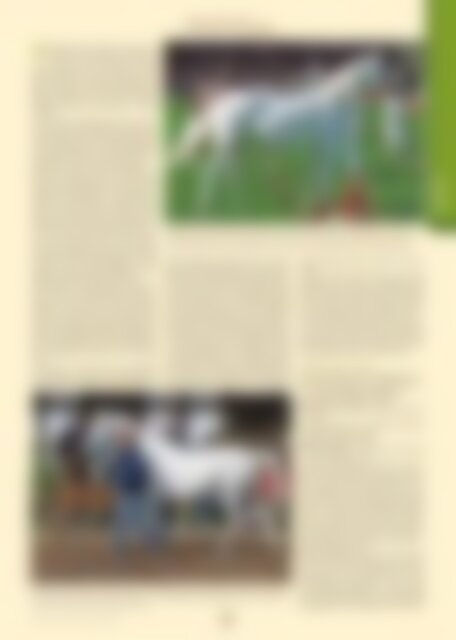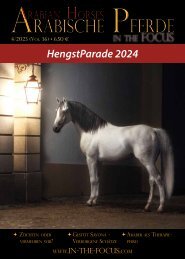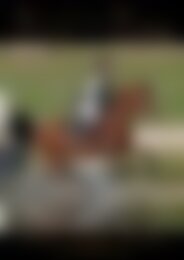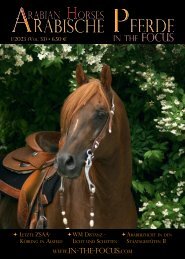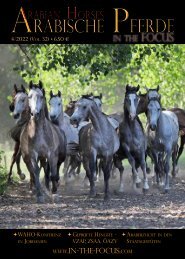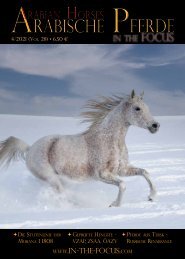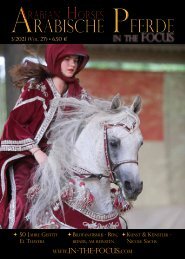Arabische Pferde IN THE FOCUS 2/2022 (Vol. 30) - public
Zeitschrift für Liebhaber und Züchter arabischer Pferde
Zeitschrift für Liebhaber und Züchter arabischer Pferde
Sie wollen auch ein ePaper? Erhöhen Sie die Reichweite Ihrer Titel.
YUMPU macht aus Druck-PDFs automatisch weboptimierte ePaper, die Google liebt.
Fotos: B. Finke, soweit nicht anderweitig vermerkt<br />
The Wege farm in Ströhen in Lower Saxony<br />
was first mentioned in documents<br />
as early as the 13th century. It has<br />
been owned by the Ismer family since 1942,<br />
when Rolf Ismer, a farmer originally from<br />
Silesia, married its then owner Annemarie<br />
Wege. Originally, the farm was diversely<br />
oriented, but then concentrated on cattle<br />
farming.<br />
In 1959, cattle breeding gave way to a new<br />
idea. A large-scale natural animal park was<br />
created, which was continuously expanded<br />
in the following years. From the beginning,<br />
the children worked in the family business,<br />
especially the two sons Erpo and Holger.<br />
Rolf Ismer wrote in the zoo’s chronicle: "My<br />
own joy and enthusiasm for wild animals,<br />
the terrain ideally suited for natural animal<br />
breeding and husbandry, and the desire to<br />
make as many people as possible happy<br />
with my facilities and the animals, led to<br />
the decision to open the zoo to the <strong>public</strong> in<br />
1960." And this is what happened on Ascension<br />
Day 1960. More than 2,000 visitors<br />
came to the opening. The zoo soon became<br />
one of the region's attramashctions and still<br />
is today. The special thing about it is that<br />
visitors can get to know Arabian horses in<br />
addition to native and exotic animals.<br />
The stud came into being almost at the same<br />
time as the zoo. Initially, Rolf Ismer bred riding<br />
ponies, which were mated to Arabian<br />
stallions. First Ghazal was used before the<br />
first own stallion came along: Demir (Hadban<br />
Enzahi / Winarsad), born in 1958 in Marbach.<br />
In 1962 Demir was the best Arabian at<br />
the stallion performance test in Westercelle,<br />
even completing a partial test as a driving<br />
horse!<br />
It was only a short step from breeding<br />
part-Arabian riding ponies to breeding purebred<br />
Arabians. The first Arabian mare was<br />
Fatme (Haladin / Winette), bred in Lütetsburg,<br />
of pure Marbach descent, but she only<br />
stayed a few years and left nothing permanent<br />
in the stud. Two other mares were more<br />
successful, both born in 1960. Dzika, bred by<br />
Hannes Gutschow, was a Ghazal daughter<br />
out of Europa by Witraz; her dam, like the<br />
Achental foundation mares, was stranded in<br />
Germany as a result of the effects of the war.<br />
The other mare was Shari I (Hadban Enzahi<br />
/ Haita by Halef), born in Marbach like Demir<br />
and going back to the old lines of Weil<br />
Stud, namely to Murana I. Together with Demir,<br />
there was now a small, solid foundation<br />
for breeding on a Marbach basis, which was<br />
further reinforced by Shari's three-quarter<br />
IS Masida (SI Sidi Rayyan / IS Mashama) *2015 tails back to the foundation mare Shari I via Mashoura<br />
and represents the dam line of Murana I. - IS Masida geht über Mashoura auf die Stammstute<br />
Shari I aus der Stutenlinie Murana I zurück.<br />
2/<strong>2022</strong> - www.in-the-focus.com<br />
31<br />
Of the three fullsisters Mashoura (pictured), Madoura and Ma Chere (all Madkour I / Shiwa),<br />
only Mashouras line has survived until today. - Von den drei <strong>Vol</strong>lschwestern Mashoura (im Bild),<br />
Madoura und Ma Chere (alle Madkour I / Shiwa) hat nur Mashouras Linie bis heute überlebt.<br />
brother Shagar (Ghazal / Haita) in the mid-<br />
1960s.<br />
In 1964, when Gertraute Griesbach stopped<br />
breeding, these horses were joined by six<br />
mares from the Achental Stud and the two<br />
Polish stallions Borys and Wisznu. Wisznu<br />
was still owned by Mrs. Griesbach, but remained<br />
in Ströhen until the end of his life.<br />
In one stroke, this made the Ismer Stud the<br />
successor to Achental and the largest purebred<br />
Arabian stud in Germany, at a time<br />
when purebred Arabians were still rare.<br />
The Achental legacy<br />
The mares taken over from Achental were:<br />
• Comtesse (Koheilan I / 250 Mersuch II-1)<br />
*1941 with her yearling daughter<br />
• Kowiszkah (by Wisznu) *1963<br />
• Rualla (Kalif / Rozka by Kuhailan Ajouz I)<br />
*1952<br />
• Inazzah (Wisznu / Isabell by Kuhailan<br />
Zaid) *1955 with her filly<br />
• Iborah (by Borys) *1964<br />
• Wiszkha (Wisznu / Kassandra (by Halef<br />
out of Kabitha)) *1956<br />
However, the old mare Comtesse, the last<br />
of the original Bábolna mares, did not produce<br />
any more foals. Kowiszkah was her<br />
last daughter, and she didn't stay in Ströhen<br />
for long either. After being covered by<br />
Shagar, she was sold to Wilhelm Kelle. She<br />
was a very fertile mare with many daughters<br />
and founded a large family, first for<br />
Wilhelm Kelle and later for the Kniffka family.<br />
Today, like many old lines, her descendants<br />
have become rare.<br />
When I visited the Ismer Stud for the first time<br />
in the fall of 1971, the three other Achental<br />
mares were still there. Meeting them - especially<br />
Wiszkha and Inazzah - was to have<br />
far-reaching consequences, as these were<br />
the first Arabian horses I had the privilege<br />
of getting to know. Together with the stal-<br />
Zucht


